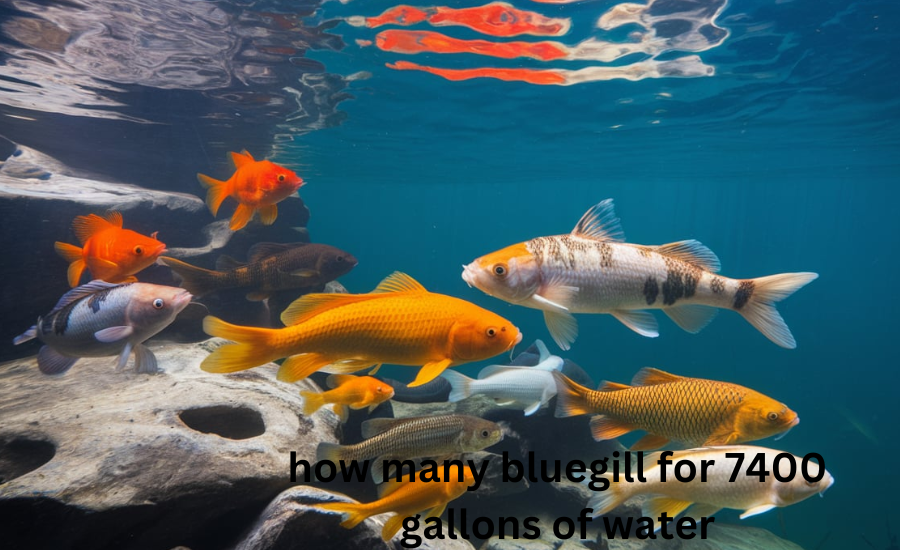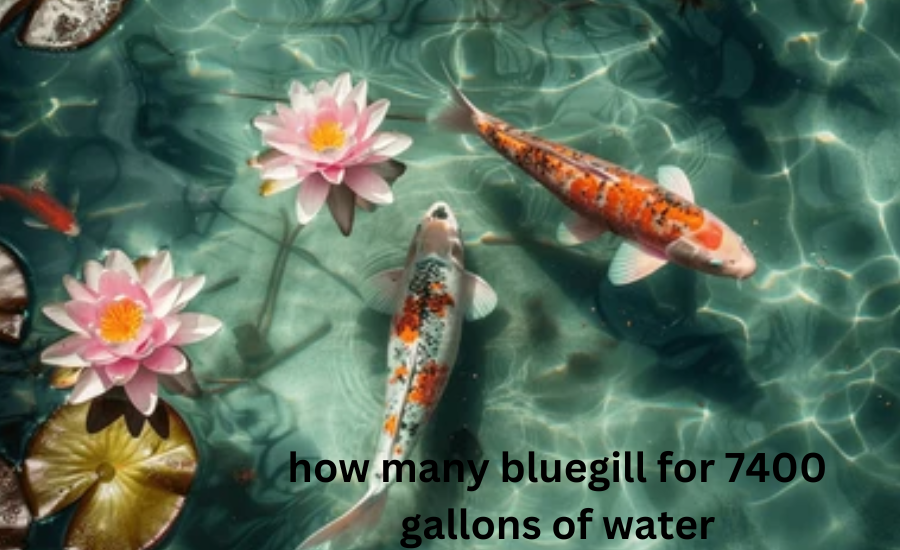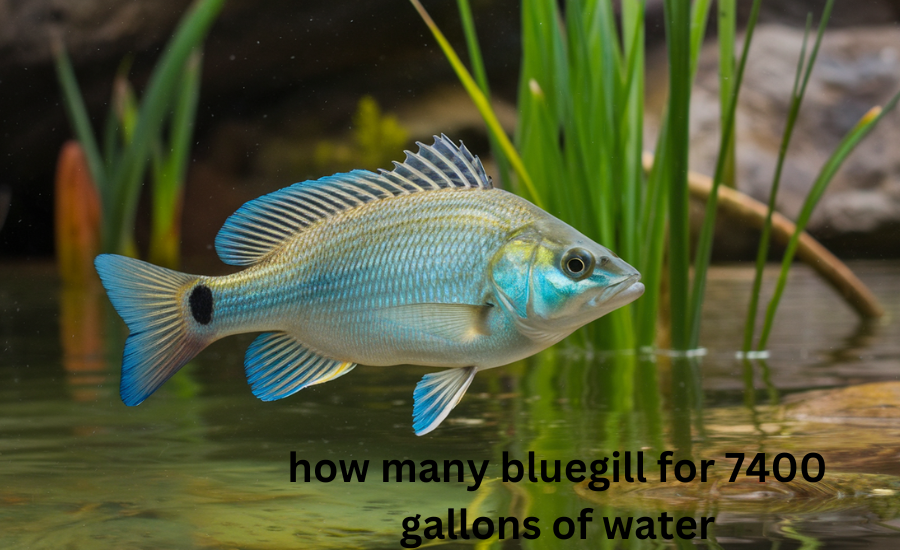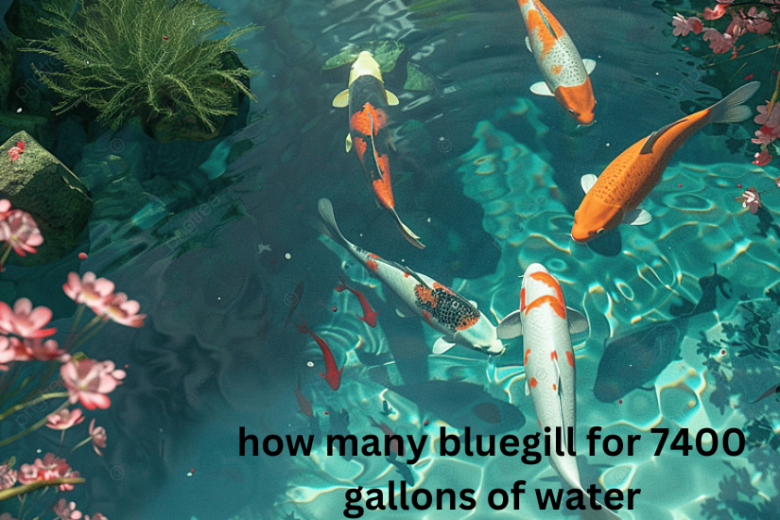Setting up a healthy pond ecosystem is a priority for many fish enthusiasts, and a key question often arises: “How many bluegill should I stock in a 7400-gallon pond? Stocking your pond with the appropriate number of fish helps maintain a balanced and healthy aquatic ecosystem This guide provides in-depth advice on stocking bluegill in your pond, helping your fish thrive while maintaining water quality.
Getting to Know Bluegill and Their Ideal Environment
Bluegill (Lepomis macrochirus) is widely regarded as an ideal fish for pond stocking, and its popularity stems from its hardiness and minimal care requirements. Native to freshwater ecosystems, including lakes, ponds, and sluggish streams, bluegills are highly adaptable and can thrive in a range of environmental conditions. Their ability to adjust to various temperatures and water quality levels makes them an excellent choice for many pond owners. Despite their adaptability, ensuring that bluegill populations thrive requires careful attention to stocking densities and pond management. Overcrowding can lead to competition for food and resources, while improper water quality can stunt fish growth and even harm their health. Therefore, it’s essential to maintain a balanced stocking approach to ensure that bluegill fish not only survive but also grow to their full potential.

When planning to introduce bluegill into a pond with a capacity of 7400 gallons, it’s important to consider more than just the volume of water. Factors such as the presence of aeration systems, the type and amount of aquatic vegetation, and potential interactions with other species all play a significant role in fostering a healthy pond environment. Aeration is particularly crucial, as bluegills require high levels of dissolved oxygen, especially in warmer months when oxygen levels tend to drop. Proper pond vegetation provides both shelter and food for the fish, enhancing their health and helping maintain water quality by reducing excess nutrients. Additionally, if there are other fish species in the pond, such as bass or catfish, the bluegill population must be carefully managed to avoid competition for resources. Balancing these factors ensures that your bluegill fish will not only survive but thrive in their new aquatic home.
The Importance of Proper Stocking Densities
Ensuring the health of your pond starts with determining the right stocking density, as this directly impacts the overall balance of the aquatic ecosystem. Overstocking, or adding too many bluegills to your 7400-gallon pond, can lead to several significant problems, such as increased competition for food and resources, which can stunt fish growth and lead to malnourishment. Additionally, overcrowding often results in oxygen depletion, as more fish consume the available dissolved oxygen at a faster rate, potentially stressing the fish and causing them to become more susceptible to disease. Poor water quality is another consequence of overstocking, as excess waste and uneaten food can contribute to an unhealthy environment, promoting harmful algae blooms and reducing water clarity. Conversely, understocking can also create problems, as it may prevent the pond from achieving a balanced ecosystem, leaving inadequate fish populations that struggle to thrive. A carefully calculated stocking density ensures the right balance of fish, supports proper growth, and maintains the overall health of the pond, creating a thriving, sustainable environment for both the fish and other aquatic life.
Stocking Bluegill: General Guidelines to Follow
A common recommendation for stocking bluegill is about 2-3 fish per 100 gallons of water. However, the specific needs of your pond—such as the presence of other species, water quality, and natural food sources—should guide your stocking decisions.
Low Stocking Density (Around 150 Bluegill)
For those who prefer a more natural and balanced pond environment, a stocking density of approximately 150 bluegills in a 7400-gallon pond is an excellent option. This level of stocking allows each fish enough space to grow and thrive without the stress of overcrowding. With fewer fish in the pond, the competition for food and oxygen is minimized, which helps maintain a healthier environment for the bluegill population. In a less densely stocked pond, each bluegill can reach its full potential, growing larger and healthier. Additionally, the reduced pressure on the pond’s resources means the water quality is easier to maintain, and the likelihood of disease outbreaks decreases. This approach is ideal for those looking for a more relaxed, low-maintenance pond with a more natural, tranquil feel, where the focus is on creating a balanced ecosystem rather than maximizing the number of fish.
Moderate Stocking Density (About 175 Bluegill)

If you are seeking a middle ground between ensuring a healthy fish population and maintaining good water quality, stocking about 175 bluegills in a 7400-gallon pond can be an ideal choice. This stocking density allows for a reasonable fish population that supports a thriving bluegill community, while still keeping the water conditions manageable. The moderate density means there will be some competition for food and resources, but not to the extent that it would result in overcrowding or stress for the fish. With this stocking level, fish can still grow well and reproduce, contributing to the pond’s long-term sustainability. Additionally, this stocking density minimizes the need for excessive pond maintenance, such as constant aeration or water quality adjustments, making it a balanced approach for most pond owners. It strikes an ideal compromise between having a sufficient number of bluegills and maintaining the health of the pond’s ecosystem.
High Stocking Density (Around 220 Bluegill)
For pond owners who are willing to invest time and resources into maintaining a high fish population, stocking up to 220 bluegills in 7400 gallons of water is a viable option. This higher stocking density is suitable for well-maintained ponds with adequate aeration, filtration, and abundant aquatic vegetation, all of which help support the larger fish population. In a pond with this level of stocking, bluegills can still thrive, but they will require more careful management. Regular feeding schedules are necessary to ensure the fish get enough nutrition, while aeration systems will need to be robust to provide sufficient oxygen for all the fish. Regular water quality testing will also be essential, as the increased fish load can lead to higher waste production, which can affect the pond’s overall health. This stocking density is ideal for those looking to maximize their fish population for recreational purposes, such as fishing, or those who want a more active aquatic environment, but it does require more hands-on involvement and consistent pond maintenance to ensure the long-term health of both the fish and the water.
Key Factors Affecting Bluegill Stocking Numbers
The decision of how many bluegill to stock for 7400 gallons of water involves more than just the volume of water. Several environmental and management factors play a role in determining the optimal number of fish:
Aeration
Bluegill requires substantial oxygen levels to survive. The more fish you introduce, the higher the oxygen demand will be. Installing aerators or fountains can support a higher stocking density by providing the necessary oxygen levels.
Vegetation
Healthy aquatic plants provide oxygen, shelter, and food for your fish. If your pond has robust vegetation, it can support a larger bluegill population, as plants help filter the water and maintain oxygen levels.
Presence of Other Species
Introducing other fish, like bass or catfish, will impact the number of bluegills you can stock. Each species competes for resources, so adjusting the bluegill population is necessary to avoid overcrowding.
Water Quality
Clean water is essential for bluegill health. Regular water testing ensures pH, ammonia, and nitrite levels are in check, which allows you to support a larger population. Poor water quality can limit the number of fish your pond can sustain.
Feeding: While bluegill generally feeds on natural food sources like insects and plankton, pond owners often supplement their diet with commercial fish food. Regular feeding can support a higher population, but overfeeding can lead to nutrient excesses, promoting algae growth and reducing oxygen levels.
How to Keep Your Bluegill Population Healthy

Once you’ve determined the right number of bluegills for your pond, maintaining their health is key to a thriving ecosystem. Here are some helpful tips for ensuring your fish and pond remain in excellent condition:
Regular Water Testing: Monitor important water parameters such as pH, ammonia, and nitrate levels. Keeping these within optimal ranges ensures the water is suitable for bluegill.
Proper Aeration: Use aerators to maintain oxygen levels, especially during warm months when oxygen can deplete quickly. Ensuring consistent aeration is crucial for fish health.
Controlled Feeding: Provide high-quality fish food and feed in moderation to prevent overnourishment, which can lead to water quality problems such as algae blooms.
Vegetation Management: While aquatic plants are important for oxygen and shelter, overgrowth can reduce swimming space for fish. Regular trimming and maintenance help balance plant and fish needs.
The Role of Bluegill in Pond Ecosystem
Bluegill play a crucial ecological role in maintaining a balanced pond environment. As opportunistic feeders, they help control insect populations by consuming a variety of aquatic larvae, including those of mosquitoes, midges, and other small invertebrates. This natural form of pest control is essential because many of these larvae, if left unchecked, can contribute to excessive algae growth, which can degrade water quality and harm the overall health of the pond ecosystem. By keeping the larvae population in check, bluegills help prevent algal blooms, which can lead to oxygen depletion and reduced water clarity. In this way, bluegills serve as natural regulators, promoting water quality and maintaining the balance of the pond’s ecosystem.

In addition to their role in controlling insect populations, bluegills are also an integral part of the food web in ponds. They serve as a primary food source for larger predatory fish species, such as bass and catfish, which rely on bluegills for nutrition. This predatory relationship ensures that bluegill populations remain in check, preventing overpopulation and ensuring that the pond does not become overcrowded. Furthermore, the presence of bluegills contributes to the biodiversity of the pond, supporting a healthy and dynamic aquatic community. By helping to regulate both the lower and higher trophic levels, bluegills play an essential role in maintaining a healthy, thriving pond ecosystem. Their contribution to controlling pests and supporting other species makes them an invaluable species for pond stocking, enhancing the overall ecological stability of the water body.
FAQs
Q: How many bluegills should I stock in my 7400-gallon pond?
A: The ideal stocking density for bluegill in a 7400-gallon pond depends on your goals and the management of the pond. A low stocking density of about 150 bluegills allows for optimal growth and health. A moderate stocking density of around 175 bluegills strikes a balance between maintaining water quality and supporting a thriving fish population. For a high stocking density, you can stock up to 220 bluegills, but this requires robust aeration, filtration, and frequent maintenance.
Q: What factors should I consider when determining how many bluegills to stock?
A: Several factors should guide your stocking decisions, including the level of aeration in the pond, the presence of aquatic vegetation, water quality, and whether other fish species (like bass or catfish) are present. Each of these influences the pond’s ability to support a healthy bluegill population. Additionally, overstocking can lead to competition for resources and poor water quality, while understocking might not provide a balanced ecosystem.
Q: What happens if I overstock my pond with bluegill?
A: Overstocking can cause a variety of issues. Too many bluegills in your pond will lead to overcrowding, which results in increased competition for food and space, stunted fish growth, and higher stress levels. It can also deplete oxygen levels in the water, increase waste production, and lower water quality, contributing to algae blooms and other harmful environmental changes.
Q: How can I maintain a healthy bluegill population in my pond?
A: To maintain a healthy bluegill population, regular water testing is essential. Monitoring parameters such as pH, ammonia, and nitrates ensures that the water remains within optimal ranges for fish health. Additionally, proper aeration is crucial, especially during the warmer months when oxygen levels tend to drop. Controlled feeding, along with vegetation management, also helps ensure a sustainable environment for bluegills.
Q: Can bluegill be stocked with other species in the same pond?
A: Yes, bluegill can be stocked with other species, such as bass or catfish, but careful management is necessary. These species may compete for resources, so it’s important to monitor the stocking densities and ensure that the bluegills are not outcompeted for food or space. The presence of other predator species also helps control bluegill populations, preventing overcrowding.
Conclusion
Stocking the right number of bluegill in a 7400-gallon pond is crucial for ensuring a balanced ecosystem. Low stocking densities (around 150 bluegills) offer a natural, low-maintenance pond, while moderate densities (around 175) provide a healthy balance, and higher densities (up to 220) can work with proper maintenance. Maintaining the health of the bluegill population involves regular water testing, aeration, controlled feeding, and managing aquatic vegetation. Bluegills play an important ecological role by controlling insect populations and supporting the food web, contributing to a sustainable and thriving pond ecosystem. Proper management of stocking densities ensures the fish’s health and the pond’s overall stability.
Read Next: fintechzoom-com-bitcoin-price
